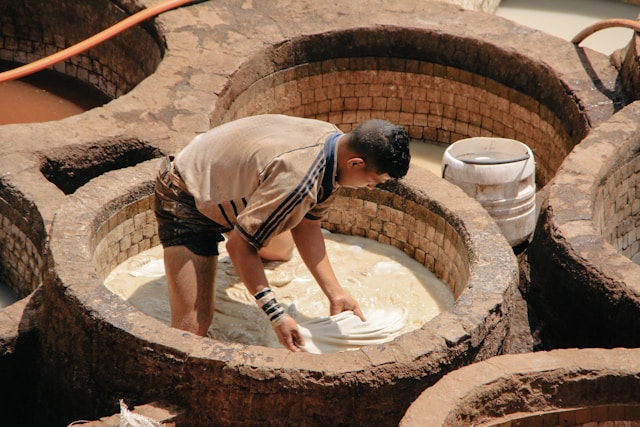Everyone wears them, everyone needs them: shoes. Whether boots, sandals, high heels, or sneakers—most of us can’t get far without them. They’re not just essential protection for our feet but also a reflection of style and personality for many. It’s no surprise that over 24 billion pairs of shoes are produced annually, most of them in Asia. However, few of us know about the miserable working conditions under which these shoes are made: low wages, long hours, and significant health risks.
LOW WAGES, HIGH STRESS
A serious issue in the countries where shoes are produced is the extremely low wages. Even the legal minimum wage is insufficient to provide workers with a decent standard of living. In shoe factories, workers put in eight hours a day, six days a week—for a monthly salary equivalent to just 70 euros. Moreover, informal employment (such as home-based work) is often prevalent, allowing employers to further reduce production costs. Workers in such conditions not only receive low pay but are also not provided with social benefits. On top of this, they have to cover additional costs like rent, electricity, and machinery themselves.
Women in southern India are particularly affected, often sewing shoes at home, working either alone or with their children. For each finished pair of shoes, they receive a maximum of 20 cents, with an average worker completing about ten pairs a day. To put that in perspective: a woman would have to labor for an entire day to earn around 2 euros.

DANGEROUS WORKING CONDITIONS
The situation in tanneries is even worse. Raw leather is heavy, safety measures are rarely in place, and accidents are common. Most of the leather (85%) is tanned using chromium salts, a method that makes the leather durable quickly and cheaply. However, the tanning process can produce Chromium VI, a highly toxic and carcinogenic substance that can be easily absorbed through the skin. Since workers in tanneries often labor without protective clothing and frequently wade barefoot through the caustic liquid, they come into daily contact with these chemicals. The result? Around 40% of tannery workers suffer from skin diseases like rashes, inflammations, and ulcers, as well as asthma and other health problems. Even more tragic is the frequent use of children for this dangerous work.
Health problems are also widespread in shoe factories, as workers there are similarly exposed to harmful chemicals. Toxic adhesives and cleaning agents containing benzene, dichloroethane, and hexane can easily enter the bloodstream through small cuts, causing severe poisoning. Protective clothing is also rarely available here. Additionally, the “vulcanisation” of latex for rubber releases toxic fumes, leading to dizziness, coughing fits, and nausea. Respiratory issues, asthma, back, and vision problems are also common in these workplaces.
“MADE IN EUROPE” – AUTOMATICALLY BETTER?

For many, it may be hard to believe, but similar systemic problems also occur in some European countries. A study by the international NGO network Change Your Shoes (2015/2016) highlighted this impressively. In six countries (Poland, Romania, Slovakia, Albania, Macedonia, and Bosnia and Herzegovina), about 179 interviews were conducted with workers producing shoes for well-known brands. The research showed that “Made in Europe” does not automatically mean better working conditions than in Asian countries.
Low wages, unpaid overtime, and a lack of work safety are also widespread in Europe. Many of the workers interviewed, similar to those in Asia, are paid based on the number of items they produce rather than hours worked. This puts workers under immense time pressure. To increase their productivity and earn more, they often work without safety gloves, exposing themselves to a higher risk of injury. Unpaid overtime is commonplace, as is the use of toxic chemicals in leather tanning and shoe production.
The health consequences are severe. Many workers report headaches, allergies, skin issues, bronchitis, and other lung problems. It is evident that the issues in the shoe and leather industry are systematic and global. There is an urgent need for international standards and stricter controls to improve working conditions and protect the health and safety of workers worldwide.
ALTERNATIVES – WHAT CAN I DO AS A CONSUMER?
So, what can we as consumers do to change our buying habits? The consumer magazine “Konsument” offers the following tips to consider when purchasing shoes:
1. Chromium-free shoes: Avoid shoes containing chromium and opt for shoes tanned with natural plant-based substances instead. You can find vegetable-tanned leather under labels such as “oak-tanned,” “vegetable-tanned,” or “plant-based tanned leather.”
2. Local manufacturers: Buy shoes from local manufacturers, such as GEA, Hartjes, or Think! Shoes.
3. Sustainable shoes: Many suppliers specialise in sustainable shoes. The website “Sustainable Consumption” from the Ministry of Life lists numerous quality seals for sustainable shoes. Vegan shoes, which are made entirely without leather, are also becoming more popular.
4. Avoid impulse purchases: Reduce the number of shoes you buy and invest in high-quality, repairable shoes instead of cheap models.
5. Don’t trust blindly: Ask questions about the manufacturing process of shoes to make informed purchasing decisions.
Translated by Anna Smith
#Ausbeutung #Schuhbranche #Schuhproduktion #Leder #ModerneSklaverei #AgainstHumanTrafficking #GegenMenschenhandel #EndExploitation #EndTrafficking #HopeForTheFuture #Österreich
